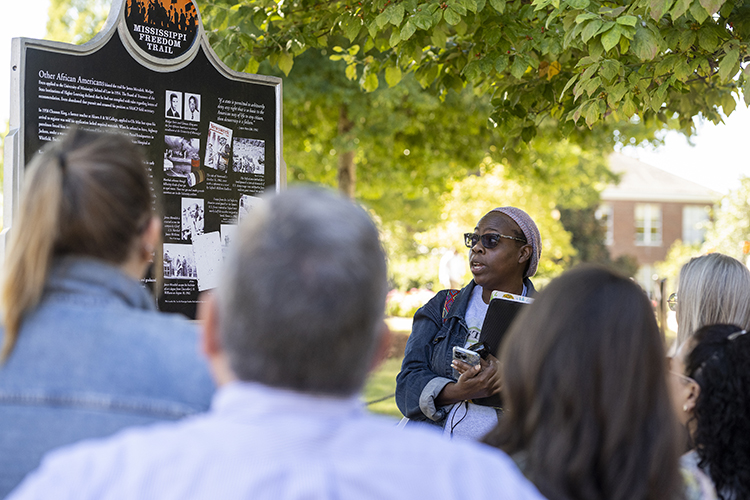
Rhondalyn Peairs (front), tour speaker and founder of Historich, an educational tourism company that organized the Civil Rights in Oxford Town bus tour, speaks about the Freedom Trail Marker on the University of Mississippi campus during a tour. Photo by Thomas Graning/Ole Miss Digital Imaging Services
As the bus pulled away from The Lyceum on Tuesday, September 27, 2022, Margaret Gipson, an African American resident and lifelong educator in Oxford, sat primly on the front row. Today, she would hear stories of integration across Oxford and at the university where her grandfather worked but was not allowed to attend.
As a part of the 60th anniversary of integration at the University of Mississippi, the Division of Diversity and Community Engagement worked with Visit Oxford to create an immersive bus tour of areas where integration happened, not just on campus but across the city. On Tuesday, the bus was lined with people eagerly snapping photos and quieting to listen to tour speaker Rhondalyn Peairs, who founded the educational tourism company Historich, which created the tour.
The bus tour, titled “Civil Rights in Oxford Town: The Integration of Education” is named for Bob Dylan‘s song “Oxford Town,” which chronicles the events of October 1, 1962, when riots broke out on the Ole Miss campus after James Meredith sought enrollment. Two people died, and more than 300 were injured.
“A lot of people believe the integration of James Meredith is this: He came, he saw, he conquered,” Peairs said. “That’s not what happened.”
Instead, integration was a series of attempts, successes and failures of scores of people over the course of decades, and it didn’t end with Meredith, Peairs said. Throughout the two-hour tour, she told stories of dozens of African Americans throughout Oxford’s history who rallied for civil rights and made an impact in the community.
Not all these figures were remembered like Meredith, Peairs said.
Gipson said her grandfather, Roger Thompson, was a custodian in 1962, and as a man who was interested in history and supportive of Meredith’s enrollment at the university, kept up with everything happening in Oxford at the time.
“My grandfather knew James Meredith, and they were great friends,” Gipson said. “My father actually would drive him around when he needed to go off of campus.”
Peairs said there are dozens of similar examples, where members of the Black community helped not only Meredith, but other African American students in the years after him.
“Students and faculty were deep in the Black community because they needed it,” Peairs said. “They needed support.”
Gipson said Peairs, a close family friend, had invited her on the tour and that she was glad to have an opportunity to better understand everything Meredith and other African American advocates for civil rights went through in Oxford.
“It’s interesting to get to know more, to get to see the history of what really went on,” Gipson said. “There is a lot we don’t really know about. … I enjoyed learning about (Meredith) but also about the people who came before him.”
The tour began beneath the stark white columns of The Lyceum, where much of the violence took place in 1962, before moving on to the statue of Meredith and the Freedom Trail marker, which details the events of late September and early October 1962.
As the bus went round the bend of The Grove, where students walked in the shade of towering oak trees, Peairs pointed out more than a half-dozen buildings on campus that have fraught racial histories. Past Farley Hall and Fulton Chapel the bus went, where, despite Dylan’s insistence that the sun won’t shine in “Oxford Town,” the day was sunny and bright.
“You look out now and think this is beautiful, but you don’t see what it took to get here,” Peairs said. “People want the beauty, but it took war and chaos to get us here.
“Keep in mind, this campus has been empowered by Black people, whether it’s the construction of the building behind me or the folks working in the kitchen. Black people have always been here.”
The tour left campus, moving through a predominantly Black-owned neighborhood, Freedmen Town, before passing by schools and finally landing at Burns-Belfry Museum and Multicultural Center, which was the first African American church in Oxford.
“The tour gives me a whole different dimension,” said Ari Lugo, UM international enrollment counselor of pre-college programs, as she looked at the museum’s exhibits. “It’s a good reminder of the places we have been, and where we should never go back.”
The university and Visit Oxford purchased the first 144 tickets for the six tours, but after those spots were all reserved and the waitlist grew long, Historich is adding two more events on September 30 and October 2. Tickets are available on Eventbrite.
By Clara Turnage







